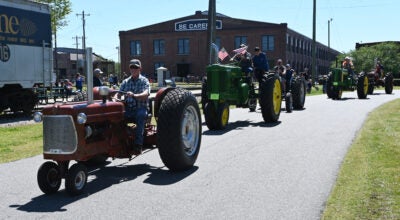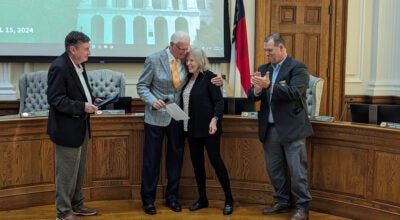Public invited to memorial services wrapping up Confederate Prison Symposium
Published 12:00 am Thursday, April 3, 2014
SALISBURY — The Robert F. Hoke Chapter No. 78 of the United Daughters of the Confederacy is inviting the public to attend the Salisbury Confederate Prison Symposium Memorial Services on Sunday.
The services are held in remembrance of the soldiers who died in Salisbury during the Civil War.
A 10 a.m. service will be held near the trenches at the Salisbury National Cemetery, 202 Government Road, for the men who died in the military prison.
The second service, for Confederate soldiers, will be held at 11 a.m. in the Old Lutheran Cemetery, 501 N. Lee St.
Mary Gorman of Massachusetts, who has researched Houstonic sailor and Salisbury prisoner of war Fred James of New York, will give the memorial address at the National Cemetery.
Annette Ford, a descendant of Commandant Maj. John H. Gee of Florida, will present the address at the Old Lutheran Cemetery.
The poem, “The Blue and The Gray” by Francis M. Finch, will be read at each service by descendants.
Mary Hines, descendant of Commandant Braxton Craven of North Carolina, will read it at the National Cemetery and Louise Weidner, descendant of POW Edward Davidson of Pennsylvania, will read it at the Old Lutheran Cemetery.
Wreaths will be placed by members of the Hoke Chapter; the Charles F. Fisher Chapter No. 73, Children of the Confederacy; the Salisbury Confederate Prison Association; and the Order of the Black Rose.
Flags will be flown representing soldiers who were in Salisbury from the states of South Carolina, Louisiana, Florida, Alabama, Texas, Mississippi, Georgia, Tennessee, Virginia, North Carolina, New York, Ohio, New Jersey, Pennsylvania, Maine, Minnesota, Indiana, Illinois, Wisconsin, Vermont, Massachusetts, Connecticut, Rhode Island, New Hampshire, Iowa, Kentucky, Delaware, California, Minnesota, West Virginia, District of Columbia, Maryland and Missouri.
Reenactors from the 88th N.Y. Infantry, Co. B; 40th NC Regiment, Co. G, Orange Light Artillery, Patterson’s Battery; and the 4th Iowa Independent Light Artillery will fire three-volley salutes after the floral tributes are placed and white balloons released. Eva Millsaps, soloist, will sing at both services.
The largest number of Union dead at Salisbury were prisoners of war. The military prison was established by the Confederate government in 1861 on land purchased by the CSA from Davidson College.
The prison was constructed with a capacity of 2,500 prisoners, but it was later enlarged when the exchange of prisoners was curtailed in the spring of 1864.
Within the wooden stockade, approximately 15,000 soldiers and civilians, mainly from the North, survived or died until it was emptied in February 1865. The 16-acre property was oddly shaped with the entrance on East Bank Street just past the railroad bridge.
The prison property included areas of Bank, Fisher, Shaver and Long Streets. The death rate, which was 2 percent prior to the fall of 1864, rose to 28 percent when the population reached 10,000 in November 1864. The total number who died in the prison was estimated by historian Louis Brown at 5,000.
Due to the large number of dead, the trench burial system was initiated. The bodies of the deceased were taken about 1-mile away to an abandoned cornfield where 18 trenches were eventually used. This burial site was designated in 1870 as the Salisbury National Cemetery. Brown believed that some Confederate soldiers also may have been buried in the cornfield.
The 175 Confederate tombstones located in a section of the Old Lutheran Cemetery were placed by the Hoke Chapter based on research by historian Jeff Stepp of the 26th NC Regiment Re-activated.
The government tombstones were erected for the chapter by a single individual, and a dedication service was held in June 1996 with the president general of the UDC in attendance.
These 175 soldiers served in units from 10 Southern states and died in Salisbury from disease, wounds or accidents. Some were guards at the prison from as far away as Alabama, some were Union prisoners who took the Oath to the Confederacy, some were soldiers who had been wounded in battle, and some were home on leave.
This cemetery also was used during the war to bury Union prisoners who died of communicable diseases, and their remains were later reinterred in the Salisbury National Cemetery.
The Salisbury Confederate Prison Symposium begins Friday night and continues during the day Saturday with various speakers at Catawba College.




